By IAN FAILES
By IAN FAILES

In the past few years the tools that visual effects and CG artists have used for traditional 2D narrative content have been rapidly changing to adapt to new immersive, VR and 360-degree projects.
One such tool is Cinema 4D from Maxon. Once primarily known for motion-graphics work, Cinema 4D has morphed into a mainstay of 3D modeling and animation and, more recently, enabled the making and rendering of virtual reality content.
“Right now the audience has been mostly people that are already fairly experienced with VR. The audience are people already attending VR film festivals or conferences, or already working in the medium, so I think the big surprises are going to be when it begins to make its way out to wider audiences as the year goes on.”
―Director Ethan Shaftel
Director Ethan Shaftel and designer and animator Frank Stringini recently relied on Cinema 4D and the CV-VR Cam plugin to make the VR film Extravaganza. The live-action and 3D-animation short immerses the viewer in a startlingly offensive puppet show, with the CG tools used in both previsualization and final animation.
Always imagining Extravaganza as a VR film – it is set inside a headset worn by a clueless corporate executive – Shaftel had a specific idea he wanted to communicate in the spirit of virtual reality.
“The central concepts of VR are point of view – who the viewer becomes, or where they are located in our VR world – and agency, what control do they have over their actions, if any,” says the director. “Because 360 video in VR makes the viewer a participant, yet does not allow them to control their actions, I decided to approach a story by making the viewer a literal puppet. That way they are controlled by outside forces against their will.”

Extravaganza’s Cinema 4D user interface.
“Everything else came out of that initial insight,” adds Shaftel. “If they are going to be a puppet participating in something outside of their control, then why not make the tension extreme by making the puppet show something at odds with the viewer’s values, to really drive that point home.”
“Because 360 video in VR makes the viewer a participant, yet does not allow them to control their actions, I decided to approach a story by making the viewer a literal puppet. That way they are controlled by outside forces against their will.”
―Director Ethan Shaftel
To give those ideas some visual identity, Shaftel and Stringini began experimenting with VR still images, something Shaftel called ‘VR storyboards’. Rough environments were outlined directly in Cinema 4D as blocks and simple shapes, then exported using the CV-VR Cam plugin to be able to view in VR headsets. (The plugin enables rendering of 360-degree stereoscopic footage out of Cinema 4D).
“It’s like being able to build a whole set from scratch in a few hours and actually look around inside,” explains Shaftel. “It was a great way to see what would be powerful in terms of scale and size. We created a simple version of our puppet body and stage set, just to see what it would look like. Throughout the writing phase, we were constantly looking around inside our mock-up VR still images to get a sense of the flow of the movie, before any actual animation took place.”
This approach to the previsualization of Extravaganza lasted throughout the development and writing process for the film. When things moved to animation, Cinema 4D continued to be used. In particular, the inflatable objects such as the balloons and ballerinas were realized with the Point Level Morph tool.
Another tool used in animation was Cinema 4D’s Character Constraint tags, which allowed for rigging and connecting the props together so that they appeared mechanized.


Extravaganza debuted at the Tribeca Film Festival’s Immersive Virtual Arcade earlier this year, after which the filmmakers honed their final version following some key feedback. They are looking forward to showing more viewers what can be done VR-wise in tools such as Cinema 4D.
“It’s like being able to build a whole set from scratch in a few hours and actually look around inside… We created a simple version of our puppet body and stage set, just to see what it would look like. Throughout the writing phase, we were constantly looking around inside our mock-up VR still images to get a sense of the flow of the movie, before any actual animation took place.”
―Director Ethan Shaftel
“Right now the audience has been mostly people that are already fairly experienced with VR,” says Shaftel. “The audience are people already attending VR film festivals or conferences, or already working in the medium, so I think the big surprises are going to be when it begins to make its way out to wider audiences as the year goes on.”